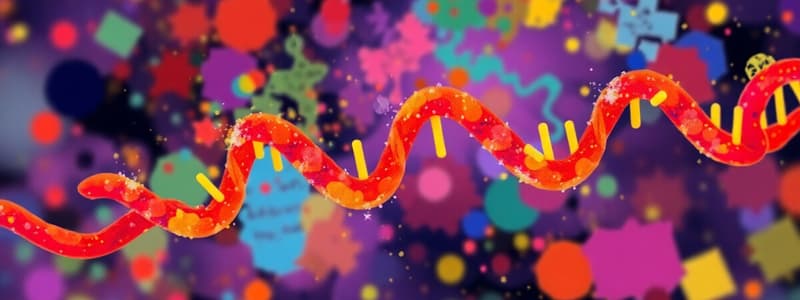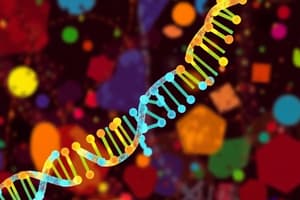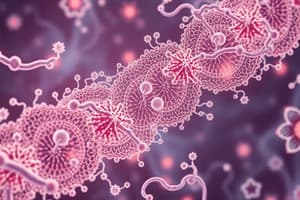Podcast
Questions and Answers
What marks the start of transcription for a gene?
What marks the start of transcription for a gene?
- The terminator sequence
- The enhancer region
- The promoter sequence (correct)
- The RNA transcript
Which term describes the direction in which RNA polymerase transcribes the template DNA strand?
Which term describes the direction in which RNA polymerase transcribes the template DNA strand?
- Transverse
- Lateral
- Downstream (correct)
- Upstream
What is the role of the sigma (σ) factor in prokaryotic transcription?
What is the role of the sigma (σ) factor in prokaryotic transcription?
- It binds to the terminator sequence.
- It halts transcription.
- It recognizes the promoter sequence. (correct)
- It initiates RNA synthesis.
How does RNA polymerase begin the transcription process?
How does RNA polymerase begin the transcription process?
Which statement about the terminator sequence is correct?
Which statement about the terminator sequence is correct?
What does a negative sign indicate in the nucleotide positions relative to the transcription start site?
What does a negative sign indicate in the nucleotide positions relative to the transcription start site?
What happens when RNA polymerase encounters the terminator during transcription?
What happens when RNA polymerase encounters the terminator during transcription?
What characterizes the binding of RNA polymerase to bacterial DNA?
What characterizes the binding of RNA polymerase to bacterial DNA?
What does the σ factor do during the initiation of transcription?
What does the σ factor do during the initiation of transcription?
During abortive initiation, what characterizes the RNA products released by RNA polymerase?
During abortive initiation, what characterizes the RNA products released by RNA polymerase?
What happens to the RNA polymerase after abortive initiation?
What happens to the RNA polymerase after abortive initiation?
How does RNA polymerase begin RNA synthesis during transcription?
How does RNA polymerase begin RNA synthesis during transcription?
What structural feature marks the region of unwound DNA during transcription?
What structural feature marks the region of unwound DNA during transcription?
What happens at the terminator during the transcription process?
What happens at the terminator during the transcription process?
What is the role of the core enzyme following transcription?
What is the role of the core enzyme following transcription?
Which mechanism allows RNA polymerase to extend the RNA chain?
Which mechanism allows RNA polymerase to extend the RNA chain?
What is the primary function of RNA polymerase I in eukaryotic cells?
What is the primary function of RNA polymerase I in eukaryotic cells?
Which RNA polymerase is responsible for the transcription of tRNAs and 5S rRNA?
Which RNA polymerase is responsible for the transcription of tRNAs and 5S rRNA?
What distinguishes eukaryotic RNA polymerases from bacterial RNA polymerase in terms of initiation factors?
What distinguishes eukaryotic RNA polymerases from bacterial RNA polymerase in terms of initiation factors?
Where does RNA polymerase II primarily operate within eukaryotic cells?
Where does RNA polymerase II primarily operate within eukaryotic cells?
What is the role of general transcription factors in eukaryotic transcription?
What is the role of general transcription factors in eukaryotic transcription?
What identifies the TATA box in a promoter region?
What identifies the TATA box in a promoter region?
What role does TFIID play at the promoter region?
What role does TFIID play at the promoter region?
Which transcription factor is considered the most complicated among the general transcription factors?
Which transcription factor is considered the most complicated among the general transcription factors?
What is the function of the TATA-binding protein (TBP)?
What is the function of the TATA-binding protein (TBP)?
What is the primary function of TFIIH during transcription initiation?
What is the primary function of TFIIH during transcription initiation?
Which of the following statements correctly describes eukaryotic transcription initiation?
Which of the following statements correctly describes eukaryotic transcription initiation?
How does RNA polymerase II transition into the elongation phase of transcription?
How does RNA polymerase II transition into the elongation phase of transcription?
What happens to RNA polymerase II after it binds to the promoter?
What happens to RNA polymerase II after it binds to the promoter?
What is required for RNA polymerase II to effectively assemble the initiation complex?
What is required for RNA polymerase II to effectively assemble the initiation complex?
What significance does the melting of approximately 14 base pairs of DNA near the transcription start site have?
What significance does the melting of approximately 14 base pairs of DNA near the transcription start site have?
What occurs after the phosphorylating of the CTD of RNA polymerase II?
What occurs after the phosphorylating of the CTD of RNA polymerase II?
What roles do RNA molecules play in the process of protein synthesis?
What roles do RNA molecules play in the process of protein synthesis?
Which statement accurately describes transcription?
Which statement accurately describes transcription?
What is one function of ribozymes in RNA?
What is one function of ribozymes in RNA?
Which of the following correctly describes the flow of genetic information?
Which of the following correctly describes the flow of genetic information?
Where does the synthesis of mRNA take place?
Where does the synthesis of mRNA take place?
What characterizes TERRA in relation to RNA?
What characterizes TERRA in relation to RNA?
What is the primary role of mRNA during translation?
What is the primary role of mRNA during translation?
Which process occurs after mRNA moves into the cytoplasm?
Which process occurs after mRNA moves into the cytoplasm?
What is the primary role of RNA polymerase during transcription?
What is the primary role of RNA polymerase during transcription?
What does the term 'pre-mRNA' refer to?
What does the term 'pre-mRNA' refer to?
In which direction is RNA synthesized during transcription?
In which direction is RNA synthesized during transcription?
Which of the following is true regarding the initiation of transcription?
Which of the following is true regarding the initiation of transcription?
What is the role of the template DNA strand during transcription?
What is the role of the template DNA strand during transcription?
How does RNA polymerase differ from DNA polymerase?
How does RNA polymerase differ from DNA polymerase?
What are codons in the context of mRNA?
What are codons in the context of mRNA?
What is the significance of RNA polymerases being processive?
What is the significance of RNA polymerases being processive?
Flashcards
Transcription
Transcription
The process of copying genetic information from DNA to RNA.
Gene
Gene
A sequence of DNA that codes for a specific protein or RNA molecule.
mRNA (messenger RNA)
mRNA (messenger RNA)
The RNA molecule that carries the genetic code from DNA to the ribosomes, where proteins are synthesized.
RNA polymerase
RNA polymerase
Signup and view all the flashcards
Codon
Codon
Signup and view all the flashcards
Elongation
Elongation
Signup and view all the flashcards
Termination
Termination
Signup and view all the flashcards
Initiation
Initiation
Signup and view all the flashcards
Translation
Translation
Signup and view all the flashcards
Ribosomes
Ribosomes
Signup and view all the flashcards
Ribozymes
Ribozymes
Signup and view all the flashcards
RNA Splicing
RNA Splicing
Signup and view all the flashcards
TERRA (Telomeric Repeat-containing RNA)
TERRA (Telomeric Repeat-containing RNA)
Signup and view all the flashcards
Central Dogma
Central Dogma
Signup and view all the flashcards
Promoter
Promoter
Signup and view all the flashcards
Downstream
Downstream
Signup and view all the flashcards
Upstream
Upstream
Signup and view all the flashcards
Sigma (σ) factor
Sigma (σ) factor
Signup and view all the flashcards
RNA polymerase holoenzyme
RNA polymerase holoenzyme
Signup and view all the flashcards
DNA unwinding
DNA unwinding
Signup and view all the flashcards
Transcription chain elongation
Transcription chain elongation
Signup and view all the flashcards
How many types of RNA polymerases do eukaryotes have?
How many types of RNA polymerases do eukaryotes have?
Signup and view all the flashcards
What does RNA polymerase I transcribe?
What does RNA polymerase I transcribe?
Signup and view all the flashcards
What does RNA polymerase II transcribe?
What does RNA polymerase II transcribe?
Signup and view all the flashcards
What does RNA polymerase III transcribe?
What does RNA polymerase III transcribe?
Signup and view all the flashcards
What is the difference between eukaryotic and bacterial RNA polymerase?
What is the difference between eukaryotic and bacterial RNA polymerase?
Signup and view all the flashcards
What are general transcription factors?
What are general transcription factors?
Signup and view all the flashcards
What is the TATA box?
What is the TATA box?
Signup and view all the flashcards
What is TFIID?
What is TFIID?
Signup and view all the flashcards
Initiation of Transcription
Initiation of Transcription
Signup and view all the flashcards
RNA polymerase-promoter closed complex
RNA polymerase-promoter closed complex
Signup and view all the flashcards
RNA polymerase-promoter open complex
RNA polymerase-promoter open complex
Signup and view all the flashcards
Abortive Initiation
Abortive Initiation
Signup and view all the flashcards
Transcription Bubble
Transcription Bubble
Signup and view all the flashcards
Sigma Factor (σ)
Sigma Factor (σ)
Signup and view all the flashcards
Elongation (Transcription)
Elongation (Transcription)
Signup and view all the flashcards
Transcription Terminator
Transcription Terminator
Signup and view all the flashcards
TATA box
TATA box
Signup and view all the flashcards
TFIID
TFIID
Signup and view all the flashcards
Transcription Initiation Complex
Transcription Initiation Complex
Signup and view all the flashcards
TFIIH
TFIIH
Signup and view all the flashcards
DNA helicase
DNA helicase
Signup and view all the flashcards
CTD (C-terminal domain)
CTD (C-terminal domain)
Signup and view all the flashcards
Phosphorylation of the CTD
Phosphorylation of the CTD
Signup and view all the flashcards
Study Notes
Nucleic Acids
- Two types of nucleic acids, deoxyribonucleic acid (DNA) and ribonucleic acid (RNA), enable living organisms to reproduce their complex components from one generation to the next
- DNA provides directions for its own replication
- DNA directs RNA synthesis and, through RNA, controls protein synthesis
RNA
- Folded domains of RNA molecules may have catalytic capacities. These catalytic RNAs are called ribozymes
- Although ribozymes are usually associated with proteins that stabilize the ribozyme structure, the RNA acts as a catalyst
- Some ribozymes can catalyze splicing, a remarkable process in which an internal RNA sequence is cut and removed, and the two resulting chains are ligated
Types of RNA
- The majority of genes in a cell's DNA specify amino acid sequences of proteins
- Some genes code for RNA molecules
- Important RNAs for transcription include:
- mRNA: Encodes proteins
- tRNA: Acts as adaptor between mRNA and amino acids
- rRNA: Forms the ribosome
- Other non-coding RNAs are used in RNA splicing, gene regulation, telomere maintenance, and many other processes
Transcription and Translation
- Genes provide instructions for making specific proteins
- A gene does not build a protein directly; the bridge is RNA
- The flow of genetic information: DNA → RNA → protein
- Getting from DNA to protein requires two major stages: transcription and translation
Transcription and Translation Diagram
Basic Principles of Transcription
- The simplest definition of a gene is a "unit of DNA that contains the information to specify synthesis of a single polypeptide chain or functional RNA" (such as tRNA).
- The vast majority of genes carry information to build protein molecules and it is RNA copies of the protein-coding genes that constitute the mRNA molecules of cells.
- During RNA synthesis, the four-base language of DNA (A, G, C, and T) is copied into the four-base language of RNA (identical except that U replaces T)
- During transcription of DNA, one DNA strand acts as a template, determining the order in which ribonucleoside triphosphate (rNTP) monomers are polymerized to form a complementary RNA chain.
- Bases in template DNA strand base-pair with complementary incoming rNTPs, which are joined in a polymerization reaction catalyzed by RNA polymerase.
- mRNA nucleotide triplets are called codons and RNA molecules are always synthesized in the 5'→3' direction.
- Transcription of a protein-coding eukaryotic gene results in pre-mRNA, and further processing yields the finished mRNA.
- The initial RNA transcript from any gene, including those specifying RNA that is not translated into protein, is more generally called a primary transcript
DNA Polymerase vs RNA Polymerase
- RNA polymerase catalyzes the linkage of ribonucleotides, not deoxyribonucleotides
- RNA polymerases can start an RNA chain without a primer; this difference is thought possible because transcription need not be as accurate as DNA replication
- RNA polymerases are absolutely processive; the same RNA polymerase that begins an RNA molecule must finish it without dissociating from the DNA template
Molecular Components of Transcription
- Steps of Transcription:
- Initiation of Transcription
- Elongation of the RNA Strand
- Termination of Transcription
Initiation of Transcription
- RNA polymerase binds to the promoter sequence in duplex DNA ("closed complex").
- RNA Polymerase melts duplex DNA near transcription start site, forming a transcription bubble ("open complex").
- RNA polymerase catalyzes phosphodiester linkage of two initial rNTPs
Elongation
- Polymerase advances 5' to 3' down template strand, melting duplex DNA and adding rNTPs to growing RNA
Termination
- At transcription stop site, polymerase releases completed RNA and dissociates from DNA.
Initiation of Transcription in Prokaryotes
- In bacteria, a subunit of RNA polymerase, the sigma (σ) factor, is primarily responsible for recognizing the promoter sequence on the DNA.
- Together, sigma factor and core enzyme (RNA polymerase holoenzyme) complex adheres weakly to bacterial DNA, slides rapidly along the long DNA molecule, then dissociates
Abortive Initiation
- RNA polymerase binds to promoter DNA to form an RNA polymerase-promoter closed complex.
- RNA polymerase unwinds one turn of DNA surrounding the transcription start site to yield an RNA polymerase-promoter open complex
- RNA polymerase enters into abortive cycles of synthesis and releases short RNA products (contains less than 10 nucleotides)
- RNA polymerase escapes the promoter and enters into the elongation step of transcription.
Transcription in Eukaryotes
-
In contrast to bacteria, which contain a single type of RNA polymerase, eukaryotic nuclei have three: RNA polymerase I, RNA polymerase II, and RNA polymerase III.
-
The three polymerases are structurally similar to one another and share some common subunits, but they transcribe different categories of genes.
- RNA polymerase I, located in the nucleolus, transcribes genes encoding precursor rRNA (pre-rRNA), which is processed into 28S, 5.8S, and 18S rRNAs.
- RNA polymerase III transcribes genes encoding tRNAs, 5S rRNA, and an array of small, stable RNAs, including one involved in RNA splicing (U6).
- RNA polymerase II transcribes most genes, including all those that encode proteins. It also produces four of the five small nuclear RNAs that take part in RNA splicing.
-
While similar in structure, bacterial and eukaryotic RNA polymerases have these differences:
- Bacterial RNA polymerase requires only a single transcription initiation factor (σ) to begin transcription, whereas eukaryotic require many such factors, collectively called general transcription factors.
- Eukaryotic transcription initiation must take place on DNA that is packaged into nucleosomes and higher-order forms of chromatin structure features that are absent from bacterial chromosomes.
Transcription in Eukaryotes (Summary)
- After binding to a promoter, RNA polymerase separates the DNA strands, making the template strand bases available for base pairing with incoming ribonucleoside triphosphates.
- Cellular RNA polymerases melt approximately 14 base pairs of DNA around the transcription start site, which is located on the template strand within the promoter region.
- Transcription initiation is considered complete when the first two ribonucleotides of an RNA chain are linked by a phosphodiester bond.
Elongation of Transcription
- After several ribonucleotides have been polymerized, RNA polymerase dissociates from the promoter DNA and general transcription factors.
- During the stage of strand elongation, RNA polymerase moves along the template DNA one base at a time, opening the double-stranded DNA in front of its direction of movement and hybridizing the strands behind it.
- One ribonucleotide at a time is added to the 3' end of the growing (nascent) RNA chain during strand elongation by the polymerase.
Termination of Transcription
- During transcription termination, the final stage in RNA synthesis, the completed RNA molecule (primary transcript) is released from the RNA polymerase, and the polymerase dissociates from the template DNA.
- Once released, an RNA polymerase is free to transcribe the same gene again or another gene.
Studying That Suits You
Use AI to generate personalized quizzes and flashcards to suit your learning preferences.




